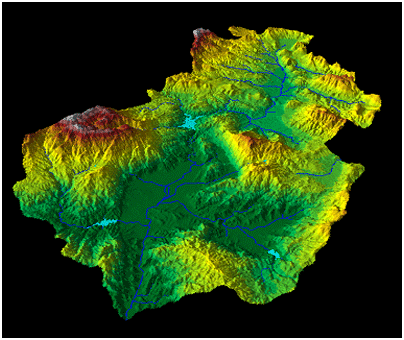Available with Spatial Analyst license.
The most common digital data of the shape of the earth's surface is cell-based digital elevation models (DEMs). This data is used as input to quantify the characteristics of the land surface.
A DEM is a raster representation of a continuous surface, usually referencing the surface of the earth. The accuracy of this data is determined primarily by the resolution (the distance between sample points). Other factors affecting accuracy are data type (integer or floating point) and the actual sampling of the surface when creating the original DEM.

Errors in DEMs are usually classified as either sinks or peaks. A sink is an area surrounded by higher elevation values and is also referred to as a depression or pit. This is an area of internal drainage. Some of these may be natural, particularly in glacial or karst areas (Mark 1988), although many sinks are imperfections in the DEM. Likewise, a spike, or peak, is an area surrounded by cells of lower value. These are more commonly natural features and are less detrimental to the calculation of flow direction.
Errors such as these, especially sinks, should be removed before attempting to derive any surface information. Sinks, being areas of internal drainage, prevent downslope flow routing of water.
Learn more about removing or filling sinks
The number of sinks in a given DEM is normally higher for coarser-resolution DEMs. Another common cause of sinks results from storing the elevation data as an integer number. This can be particularly troublesome in areas of low vertical relief. It is not uncommon to find 1 percent of the cells in a 30-meter-resolution DEM to be sinks. This can increase as much as 5 percent for a 3-arc-second DEM.
DEMs may also contain noticeable striping artifacts, a result of systematic sampling errors when creating the DEM. Again, this is most noticeable on integer data in flat areas.
The hydrologic analysis tools are designed to model the convergence of flow across a natural terrain surface. There is an assumption that the surface contains sufficient vertical relief that a flow path can be determined. The tools operate on the assumption that for any single cell, water can flow in from many adjacent cells but out through only one cell.